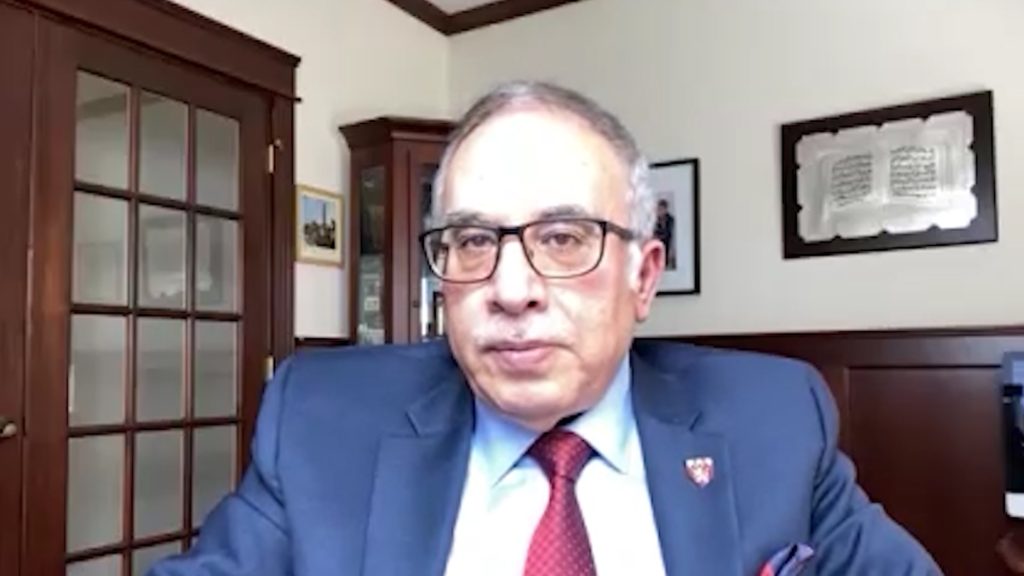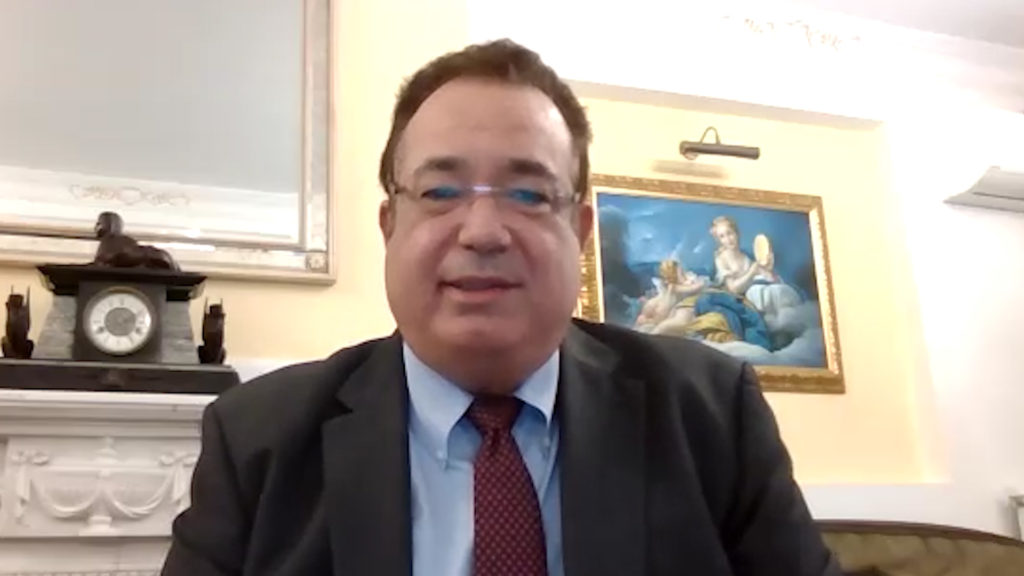Dr Sudhir Bansal is an internist with a solo practice specializing in endocrinology. Like others in this field, he has been dealing with the professional and personal changes precipitated by the coronavirus pandemic. What follows are his observations in response to these changes.
The COVID-19 pandemic has resulted in closure of multiple businesses. Health care was considered an essential need and hence allowed to stay open. The individuals identified as infected in the initial stages were those seriously afflicted and their medical needs became the focus of attention. The initial experienced virulence of the illness overwhelmed the first responders. In these uncertain times the need to provide medical care persisted for the population at large and especially those with chronic illnesses, such as diabetes, who had a chance of being neglected. Patients who were elderly and had a chronic illness, even though not infected, felt threatened. Medical practices with no past experience of a similar widespread illness tried to meet these perceived needs. At present, in America, practices are generally group practices and corporate owned. Their day-to-day decisions are not in the hands of individual practitioners and are often made by non-physicians.1 My practice, by contrast, is a solo practice, run by the owner and hence is in a position to make and implement changes as the situation demands.
The practice where I’m based provides care to a high-risk population of elderly patients with diabetes with additional comorbidities. Despite being a subspecialist, a number of these patients view me as a primary care provider even while having a primary care physician of record.2 This population, during normal times, has a higher utilization of medical resources, makes more visits to the doctors, and uses more medications. Their visits require both clinical and biochemical evaluations. Provision of this work during the epidemic, for a single practice with 2,000 enrolled patients, has required 20 hours of clinical work for a single physician plus that of a medical assistant. The medical assistant, while performing duties such as obtaining laboratory results, ordering prescriptions, and confirming scheduled visits in person or tele-visit, has been required to work an additional 15 hours per week while our workload of seeing patients has reduced by half. Patients perceive reduced needs for ongoing care of chronic problems but require support of the medical assistant for administrative needs. We currently see an average of 80 patients a week with about half being tele-visits.
COVID-19-related care
Caring for patients with COVID-19 has continued to evolve on a daily basis. Availability of resources, such as increased testing capabilities, improved understanding of the disease, new medications, as well as coming out from confinement all have posed new questions. In the last week of March, the practice was primarily triaging patients, and by answering their questions, kept them from going to hospitals to obtain perceived care needs from emergency rooms. Since most of these patients had mild symptoms of an upper respiratory illness fueled by anxiety from seeing the news, our role was more of a pacifier.
During the first 2 weeks, only one patient was referred to the hospital. In the absence of doing actual tests we carefully watched those we had been in touch with; this provided a sense of comfort to them. A simple technique of asking patients how many steps they could take in 15 minutes before being short of breath helped to objectively quantify a purely subjective feeling of being “probably short of breath”. Now, in addition to using temperature recordings at home, one could use an objective marker. However, a great surprise was how few had a thermometer at home or could follow a walking schedule without being prompted to do so. As testing became more available, we have ordered tests more frequently. A total of 30 patients have been triaged and counseled, to date.
Despite explaining that testing in the case of this disease state only accomplishes stopping the spread of disease and not its management, those who have been tested continue to be concerned about the outcome of the test results. A daily call at a fixed time has allayed anxiety caused by result delays while confirming the patient’s clinical status. To date I have ordered 20 tests and all except one has turned out to be negative. The positive case, who has multiple sclerosis and is a care provider for her elderly mother, was clearly concerned about her mother when first tested and was somewhat in disbelief of her diagnosis due to her paucity of symptoms and their near disappearance in the 48 hour turn-around time for the test. We were, however, successful in maintaining quarantine for her for the duration required for safety of the rest of the family members including her mother (all family members have turned positive as I write).
Despite the fact that elderly patients with diabetes have made up a large proportion of those who have contracted the illness and have had poor outcome, we have not seen this in our own practice. Though it is clearly possible that we may not be aware of some patients experiencing the illness, the close-knit nature of the Rhode Island population makes this unlikely. Of course, this may represent reduced incidence of COVID-19 in our state, but it could as likely represents the better health and social strata of our diabetic patients.3 Guidelines provided by experts in diabetes recently reinforce that provision and maintenance of good care is crucial for this at-risk population.4
Non-COVID-19 related care
By staying open, the practice has provided for chronic (diabetes related), as well as acute, care needs as they arose. Our patients have clearly expressed comfort even in the absence of needs, knowing that we are available. Our office fields approximately 100 telephone calls during our working hours and while some are administrative others are clinically relevant issues.
The clinical issues have related to incidental illness such as gout, shingles, renal colic, and a dental abscess treated with antibiotics until the dental surgeons were available. Tele-visits with subspecialists have resulted in more questions from our patients such as “don’t know what the subspecialist I went to said. Can you please explain”. A brittle, insulin dependent diabetic with recently diagnosed laryngeal cancer whose surgery was postponed, has weathered the storm by paying us daily visits. Anxious patients, previously with stable glucose balance, especially those living alone, have sought frequent advice due to fluctuating blood glucose readings. Our message to avoid alcohol or smoking to relieve stress may help health outcomes in the future. Use of short-acting anxiolytics implemented in some patients has helped avoid visits to emergency rooms.
Provision of these services has been much easier from the office than at a non-office location due to the availability of office records, multiple telephone lines, and office staff. Renewal of prescriptions with the notes (paper-charts) and laboratory result evaluations was easily accomplished. Self-reports of the thyroid increasing in size since their last appointment have been quickly resolved by visual examination to rule out acute inflammation of the thyroid as recently reported.5 Side effects of newly-initiated medications have been monitored, allowing an easy switch to another when needed. We still continue to get approval for restricted medicines needed for the care of chronic illnesses like diabetes and osteoporosis.
Tele-visits can provide a certain fraction of care but they are not meant for all, as is evident from the number of visits to the office in person. A recent publication on the tele-visit has shown its utility but also points out its shortcomings.6 Some of this may relate to the population being treated while also has to do with the provider’s age and training. We fear the shift from clinical management to indices such as laboratory evaluations and worry that this shift discredits the Victorian invention of the stethoscope and physical examination involving sense of touch. Data have been presented to justify electronic consults, but it requires a total paradigm shift and though may satisfy the professional colleague by providing an answer, it still may not always provide satisfaction to the consumer.
Consultants, at times, may be better communicators than more astute clinicians. This epidemic may lead to a revaluation of the continued need for a clinician subspecialist in ongoing care. Looking in the near term, we are preparing to face and meet expectations of what is safe in the new era of returning back to regular life. Though no data are available, to our knowledge, we speculate that survivors with comorbidities may mount a poor antibody response, and hence they should not be moving out of a protected environment. Also, those with comorbidity but no actual illness should allow the healthier population to be the early ones to return to their regular environment. The daily evolution of antibody testing data will answer some of these questions.
Help for provider
Going to the office has allowed me to be more comfortable with my medical decisions. It has maintained a structured time evaluation for patients since they are called at previously specified times. The availability of a health professional allays a lot of anxiety but is further invaluable if performed by someone whom a patient has come to trust through years of contact. Being subspecialists, we cannot abandon new referrals because, waiting though safe, may cause unwarranted anxiety for the patient. While recent publications talk about increased burnout, I view this work in a spiritual dimension where circumstances beyond human control have required increasing responsibility. Viewing it as work weighs us down but viewing it in a sense of duty is uplifting in a Hippocratic way.
As time evolves, the face of medicine will change. At present my practice has encompassed needs, which are applicable to practices like mine but not to larger volume multispecialty practices, which may still use some aspects of what is reported. The epidemic has forced me to awake earlier and view at least six nationally recognized platforms to field questions from patients with confidence. The model of going in to the office has allowed me to weather the storm of COVID-19 needs but is not economically viable for a practice. In closing, I must state that my patients have provided a routine for me and have thus unknowingly helped me to personally get through this crisis. It reminds me of an old saying “my son, more than the calf wishes to suck, does the cow yearn to suckle.”
References
- Thoronson R. Lost Space. JAMA. 2020; doi: 10.1001/jama.2020.7237 [Online ahead of print].
- Spiegel JS, Rubenstein LV, Scott B et. al. Who is the primary physician? N Engl J Med. 1983;308:1208–12.
- Zhu L,She ZG,Cheng x,et al. Association of Blood Glucose Control and Outcomes in Patients with COVID-19 and Pre-existing Type 2 Diabetes. Cell Metabolism. 2020; 31(6):1068-1077.e3.doi:10. 1016/j.cmet.2020.04.021
- Hartzband P, Groopman J. Physician burnout, Interrupted. N Engl J Med. 2020;doi: 10.1056/NEJMp2003149 [Online ahead of print].
- Brancatella A, Ricci D, Viola N, et. al. Subacute thyroiditis after SARS-Cov-2 infection. J Clin Endocrinol Metab. 2020;105: https://doi.org/10.1210/clinem/dgaa276.
- Bornstein SR, Rubino F, Khunti K, et. al. Practical recommendations for the management od diabetes in patients with COVID-19. Lancet Diabetes Endocrinol. 2020;8:546–50.
Disclosure: Sudhir Bansal has no financial or non-financial conflicts of interest to declare in relation to this article.
Support: Developed and supported by Touch Medical Media.
Published: 15 June 2020





